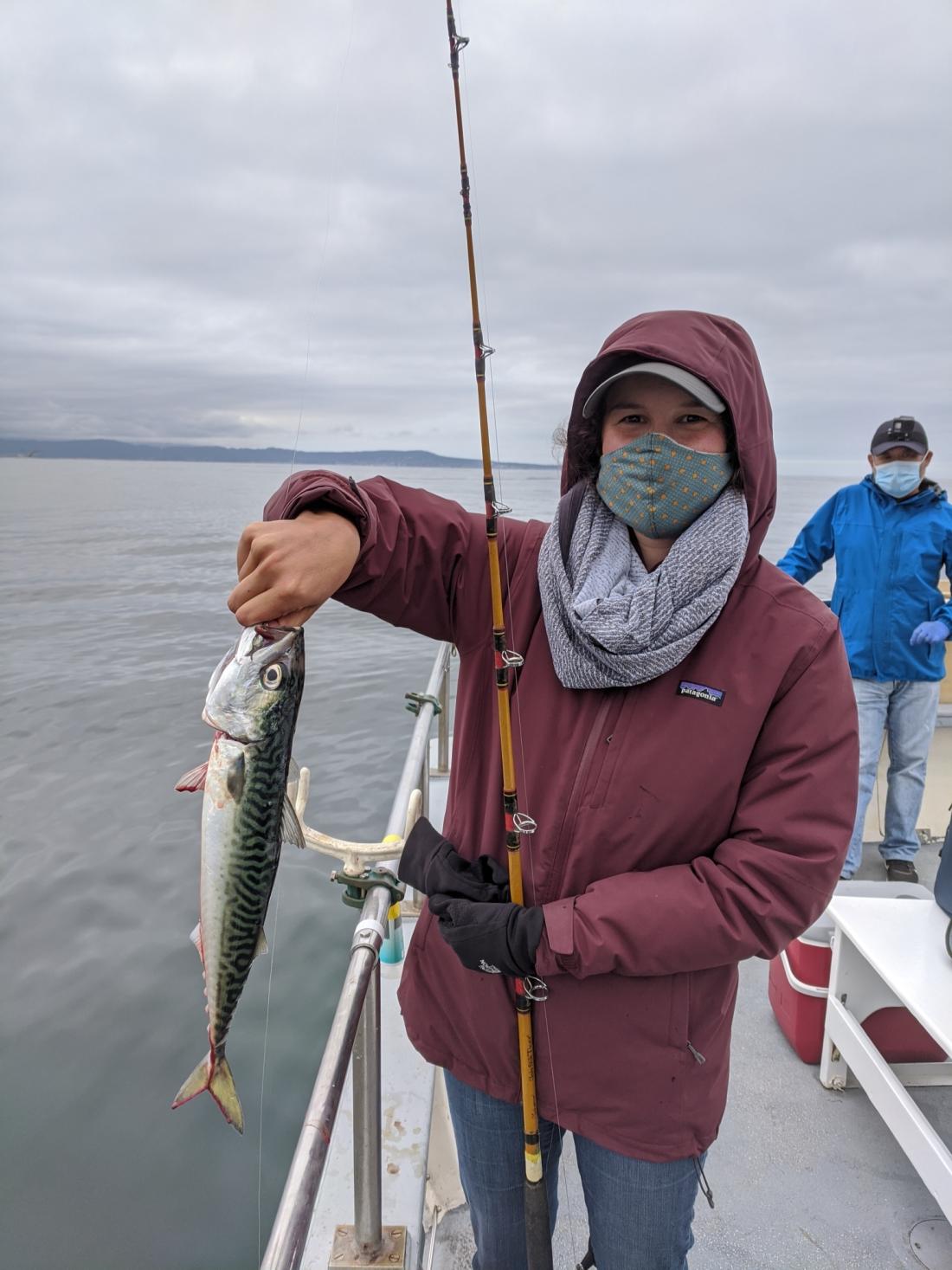Pacific Mackerel
Scomber japonicus
The Science
THE SCIENCE
Unlike its Atlantic counterpart, Pacific mackerel has an unmarked belly! [5]

Taxonomic description
- Has a tapered, large-mouthed fish with dark blue, pointy head. [1]
- Has a dark blue back with wavy dark lines, silvery green undersides. [1]
- Reaches lengths up to 63 cm (25 in) and weight up to 2.7 kg (6 lbs). [1]
- Swim bladder is attached to its esophagus via a pneumatic duct. [2,15]
- Has large eyes relative to other mackerel species. [2]
Distribution
- Ranges from southeastern Alaska to Mexico. [1]
- Most common south of Point Conception, California. [1]
- Migrates north to Washington in summer, south to Baja California in winter. [1,2]
Life history
- Can live up to 18 years.
- As a fast grower, it is able to reproduce by 4 years of age.
- Spawns from late April to September off of California, spawning events take place several times a year and yields about 70,000 eggs each time.
- Found in dense schools as a defense mechanism against predators, often with other pelagic species. [2]
- Feeds on plankton, other pelagic fish (e.g. sardine, anchovy) and its own young. [1,2]
- Is eaten by sharks, tunas, marine mammals, and seabirds. [1,2]
Habitat
- Usually lives within 20 miles offshore in water between 50 and 72 degrees.
- Moves inshore and offshore seasonally off California, and is more abundant inshore from July to November, and offshore March to May. [1]
- Juveniles frequent sandy beaches, kelp beds, open bays, and congregate at piers. [1]
The Fishery
THE FISHERY
Pacific mackerel reached its catching peak in 1978 with 3,412,602 tons!

Seasonal availability
- Available year-round, though it is more abundant in summer. [1]
Regulatory and managing authority
- The Pacific Mackerel fishery is managed federally by the NOAA fisheries and, as established by the Magnuson-Stevens Act, the Pacific Fishery Management Council (PFMC) through the Coastal Pelagic Species Fishery Management Plan (CPSFMP). [1]
- As established by the Marine Life Management Act, the California Fish and Game Commission (CFGC) regulates the fishery in state waters, and the California Department of Fish and Wildlife (CDFW) collects data and helps enforce FMP management rules for this fishery through the Pelagic Fisheries and Ecosystems Program. [6,8]
- The California Wetfish Producers Association combines input from the industry and government entities to inform regulatory and management measures for this fishery. [7]
Gear type
- Commercial fisheries use round haul gear consisting of purse-seines, lampara nets, drum seines, and dip nets. [2]
Status of the fishery
- Currently harvested by two fisheries, commercial and sport fishing, both localized in Southern California. [1,3]
- The stock collapsed in 1960s, resulting in moratorium on the fishery in the 1970s. [2]
- The stock recovered in the late 1970s, but demand has not rebounded for canned mackerel so harvest remains low. [2]
- The last mackerel cannery in Southern California closed in 1992 with diminished demand for the product. [2]
- Recent landings fall well under sustainable harvest limits. [1,3]
Potential ecosystem impacts
- Harvesting with round haul gear takes place in surface waters, minimally impacting the environment. [1]
- The schooling lifestyle of Pacific mackerel means bycatch is low, as individuals are densely grouped together. [1]
- Bycatch primarily consists of other coastal pelagic fish species. [1]
The Seafood
THE SEAFOOD
In the kitchen and market, the fish is in the best condition if the meat is firm and the eyes are clear with the colors bright.

Edible portions
- Pacific mackerel is sold fresh, frozen, or cured; whole or filleted.
Description of meat
- It has firm, oily, dark meat with a strong flavor, rich in omega-3 fatty acids. [1]
- Mackerel has large bones which are easily removed from the cooked flesh. [4]
- The meat spoils quickly - this fish should be promptly frozen, refrigerated, or cured. [4]
Culinary uses
- It is best prepared without adding additional oils or fats to the meat, i.e. roasted, baked, or grilled, as the naturally oily meat self-bastes during cooking. [4]
- Mackerel's robust flavor is well-complemented by acidic, spice-heavy, or fruity sauces. [4]
- For a Nigerian Mackerel and Tomato Sauce recipe, visit Nigerian Lazy Chef. [9]
- For a Filipino recipe for Fish kinilaw, visit SCMP Cooking. [10]
Nutritional information
- Nutritional information for 100g of Pacific Mackerel is shown on the table to the right. [1]
Toxicity report
- No known contaminants. [1]
Seasonal availability
- Year round. [1]
References
[1] NOAA FishWatch. 2020. Pacific mackerel. Web. https://www.fishwatch.gov/profiles/pacific-mackerel. Accessed 4 Sept 2020.
[2] Kramer, D. Synopsis of the Biological Data on the Pacific Mackerel, Scomber Japonicus Houttuyn. FAO Fisheries Synopsis No. 40. US Fish and Wildlife Service. 1969. www.fao.org/docrep/017/ap916e/ap916e.pdf.
[3] Pacific Mackerel. California Dept. of Fish and Wildlife. 2014. www.dfg.ca.gov/marine/cpshms/pacificmackerel.asp
[4] BBC Good Food, Glossary: Mackerel. http://www.bbcgoodfood.com/glossary/mackerel.
[5] Luna, S.M. n.d. Fish Base. Scomber japonicus, Chub mackerel. Web. https://www.fishbase.se/summary/Scomber-japonicus.html. Accessed 28 Sept 2020.
[6] Marine Life Management Act. n.d. California Department of Fish and Wildlife. Web. https://wildlife.ca.gov/Conservation/Marine/MLMA. Accessed 24 August 2020.
[7] California Wetfish Producers Association. 2013. California Wetfish Producers Association. Web. https://californiawetfish.org/. Accessed 2 December 2020.
[8] Overview of the Pelagic Fisheries and Ecosystems Program. n.d. California Department of Fish and Wildlife. Web. https://wildlife.ca.gov/Conservation/Marine/Pelagic#52132542-overview. Accessed 9 December 2020.
[9] Okpara, N. Nigerian Lazy Chef. 2016. Mackerel and Tomato Sauce. Web. http://www.nigerianlazychef.com/2016/06/mackerel-and-tomato-sauce/. Accessed 19 January 2021.
[10] South China Morning Post. n.d. Fish kinilaw-Filipino ceviche. Web. https://www.scmp.com/cooking/recipe/fish-kinilaw/article/3029585. Accessed 19 January 2021.
[11] Houston, J. flickr. 2015. Fisheries in San Diego, CA. Digital image. Web. https://flickr.com/photos/caseagrant/38296336874/in/album-7215768921645…. Accessed 22 February 2021.
[12] Krohn, A. iNaturalist. 2020. Digital image. Web. https://www.inaturalist.org/photos/76464770. Accessed 22 February 2021.
[13] katorisi. Wikipedia. 2007. Okhotsk atka mackerel. Digital image. Web. https://en.wikipedia.org/wiki/Mackerel_as_food#/media/File:Okhostk_atka…. Accessed 22 February 2021.
[14] Robertson, D.R. Smithsonian Tropical Research Institute (STRI), https://stri.si.edu/scientist/d-ross-robertson
[15] Castro Hernández, J.J.; Santana Ortega, A.T. Synopsis of biological data on the chub mackerel (Scomber japonicus Houttuyn, 1782). FAO Fisheries Synorsis. No. 157. Rome, FAO. 2000. 77p. Accessed 11 January 2022.



